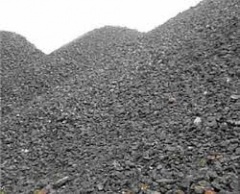Ores
| Infobox on Ores | |
|---|---|
| Example of Ores |  |
| Facts | |
| Origin | - |
| Stowage factor (in m3/t) | 0,29-0,80 m2/t (iron ore) |
| Humidity / moisture | - |
| Ventilation | No special requirements |
| Risk factors | See text |
Ores
Contents
Description
An ore is a type of rock that contains minerals with important elements including metals. The ores are extracted through mining; these are then refined to extract the valuable element(s).
The grade or concentration of an ore mineral, or metal, as well as its form of occurrence, will directly affect the costs associated with mining the ore. The cost of extraction must thus be weighed against the metal value contained in the rock to determine what ore can be processed and what ore is of too low a grade to be worth mining. Metal ores are generally oxides, sulfides, silicates, or "native" metals (such as native copper) that are not commonly concentrated in the Earth's crust or "noble" metals (not usually forming compounds) such as gold. The ores must be processed to extract the metals of interest from the waste rock and from the ore minerals. Ore bodies are formed by a variety of geological processes. The process of ore formation is called ore genesis.
Ores (metals) are traded internationally and comprise a sizeable portion of international trade in raw materials both in value and volume. This is because the worldwide distribution of ores is unequal and dislocated from locations of peak demand and from smelting infrastructure.
Most base metals (copper, lead, zinc, nickel) are traded internationally on the London Metal Exchange, with smaller stockpiles and metals exchanges monitored by the COMEX and NYMEX exchanges in the United States and the Shanghai Futures Exchange in China.
Iron ore is traded between customer and producer, though various benchmark prices are set quarterly between the major mining conglomerates and the major consumers, and this sets the stage for smaller participants.
Other, lesser, commodities do not have international clearing houses and benchmark prices, with most prices negotiated between suppliers and customers one-on-one. This generally makes determining the price of ores of this nature opaque and difficult. Such metals include lithium, niobium-tantalum, bismuth, antimony and rare earths. Most of these commodities are also dominated by one or two major suppliers with >60% of the world's reserves. The London Metal Exchange aims to add uranium to its list of metals on warrant.
The World Bank reports that China was the top importer of ores and metals in 2005 followed by the USA and Japan.
Application
Ore is an aggregate of valuable minerals and gangue from which one or more metals can be extracted at a profit.
Shipment / Storage / Risk factors
In (Bulk) vessels
Ore shipments are transported from mines to the loading vessel by various means, including rail, road transport or by craft, and a certain loss may occur during transit and during loading operations.
In many cases the weight of the cargo loaded is measured by taking the draught of the vessel, but the weight so ascertained is not absolutely reliable. In calm weather and under normal conditions measurements so ascertained are recognized as being generally reliable. Shipped weights are sometimes provided by vehicles passing over a weigh-bridge, prior to shipment, but such weights are not necessarily evidence of the quantity loaded, by reason of the margin of error which must be allowed and the loss which may take place during the actual loading operations, particularly if the ore is dry and dusty. Similarly, methods of determining the arrived weight at the port of discharge vary and are subject to the same considerations.
The weight at destination may also vary due to the drying out of the natural water content during transit and loss due to such cause may differ considerably, as in wet weather the ore is likely to contain an excess over and above its natural moisture content. It is usual for the moisture content of the ore to be determined at the time of shipment by a chemical analysis of samples drawn during loading, and it is customary for the ore to be bought on the calculated dry weight.
Ores of various types should in general be kept separate, the mixing of one with another being likely to result in an appreciable claim. This is of particular importance where, arising out of a casualty, cargo has to be discharged at a port of refuge and interim storage facilities are limited. Ores are often carried by ships as concentrates which may liquefy and which may present self-heating properties in bulk (e.g., metal sulphides concentrates). Must be kept separated from other cargoes to avoid damage from sifting, moisture or contamination.
In container(s)
Bulk ores in dry and fine-grained condition may have shifting characteristics similar to grain. Depending on the variety of ores in purified or washed (gritty) condition, the collective name "Concentrates" has to be marked on the container.
Mixing of concentrates and ores has at all times to be avoided even when both are of the same type, e.g. Chrome Ore and chrome concentrate. Stowing two types of bulk ore in the same container is not allowed as contamination may lead to considerable claims. Chrome ore affects other commodities and similarly it should be protected from contamination by other cargoes.
Reference is made to the International Maritime Solid Bulk Cargoes Code.











